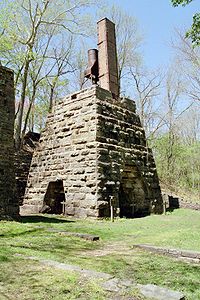
Maramec Spring
Encyclopedia

Missouri
Missouri is a US state located in the Midwestern United States, bordered by Iowa, Illinois, Kentucky, Tennessee, Arkansas, Oklahoma, Kansas and Nebraska. With a 2010 population of 5,988,927, Missouri is the 18th most populous state in the nation and the fifth most populous in the Midwest. It...
. The fifth largest spring
Spring (hydrosphere)
A spring—also known as a rising or resurgence—is a component of the hydrosphere. Specifically, it is any natural situation where water flows to the surface of the earth from underground...
in the state with an average daily discharge of 153 cubic feet (4.3 m³) of water per second, it is part of an area known for its karst topography
Karst topography
Karst topography is a geologic formation shaped by the dissolution of a layer or layers of soluble bedrock, usually carbonate rock such as limestone or dolomite, but has also been documented for weathering resistant rocks like quartzite given the right conditions.Due to subterranean drainage, there...
with many springs and caves. The spring and 1800 acres (7.3 km²) are privately owned by the James Foundation which maintains the area as a park open to the public. The Missouri Department of Conservation
Missouri Department of Conservation
The Missouri Department of Conservation and the Missouri Conservation Commission were created by Article IV Sections 40-42 of the Missouri Constitution, which were adopted by the voters of the state in 1936 as Amendment 4 to the constitution...
operates a trout
Trout
Trout is the name for a number of species of freshwater and saltwater fish belonging to the Salmoninae subfamily of the family Salmonidae. Salmon belong to the same family as trout. Most salmon species spend almost all their lives in salt water...
hatchery
Fish hatchery
A fish hatchery is a "place for artificial breeding, hatching and rearing through the early life stages of animals, finfish and shellfish in particular". Hatcheries produce larval and juvenile fish primarily to support the aquaculture industry where they are transferred to on-growing systems...
and fishery at the spring. There are also ruins of a historic iron works, which took advantage of the available hydropower. The spring was declared a National Natural Landmark
National Natural Landmark
The National Natural Landmark program recognizes and encourages the conservation of outstanding examples of the natural history of the United States. It is the only natural areas program of national scope that identifies and recognizes the best examples of biological and geological features in...
in October 1971.
Description
The spring has an average daily discharge of about 99 million gallons (363 million liters)USGS. The natural history of the spring and the history of the iron works are highlighted in a museum operated by the James Foundation at the site. Another museum in the park features agricultural tools utilized in the area over the years.The park also offers a scenic drive that offers a glimpse into the life in the area while the iron works were operating. The drive takes the viewer to a scenic overview of the park, an old cemetery populated with employees of the works, the iron pit mine, and locations of a few homesteads. The park is also covered with ample picnic areas, including pavilions that are suitable for events.
Maramec Iron Works

Mississippi River
The Mississippi River is the largest river system in North America. Flowing entirely in the United States, this river rises in western Minnesota and meanders slowly southwards for to the Mississippi River Delta at the Gulf of Mexico. With its many tributaries, the Mississippi's watershed drains...
, they produced iron from 1827 to 1891. During the US Civil War, it produced iron for cannonballs and James B. Eads' gunships, which were built in St. Louis
St. Louis, Missouri
St. Louis is an independent city on the eastern border of Missouri, United States. With a population of 319,294, it was the 58th-largest U.S. city at the 2010 U.S. Census. The Greater St...
near the mouth of the river. The iron works used the flow of water from the spring to power
Hydropower
Hydropower, hydraulic power, hydrokinetic power or water power is power that is derived from the force or energy of falling water, which may be harnessed for useful purposes. Since ancient times, hydropower has been used for irrigation and the operation of various mechanical devices, such as...
its machinery to process high-grade iron ore quarried in the form of hematite
Hematite
Hematite, also spelled as haematite, is the mineral form of iron oxide , one of several iron oxides. Hematite crystallizes in the rhombohedral system, and it has the same crystal structure as ilmenite and corundum...
from a nearby pit.
In October every year, the James Foundation hosts Old Iron Works Days, usually the second or third weekend of the month. This event features arts, crafts, foods, displays and presentations that provide a view of life in the area during the operation of the iron works.
Recreational activities
The park is one of four trout parks in Missouri and allows fishing most of the year. Harvesting season starts March 1 each year and runs until the beginning of October, while the catch and release season runs during the winter months. The stream is restocked every day during fishing season from the 100,000 trout produced by the hatchery each year.There are 58 campsites in the park, ten of which have electric hook-ups. The park has numerous picnic sites, six reserveable picnic shelters, and multiple playgrounds.
External links
- Official site: MaramecSpringPark.com

